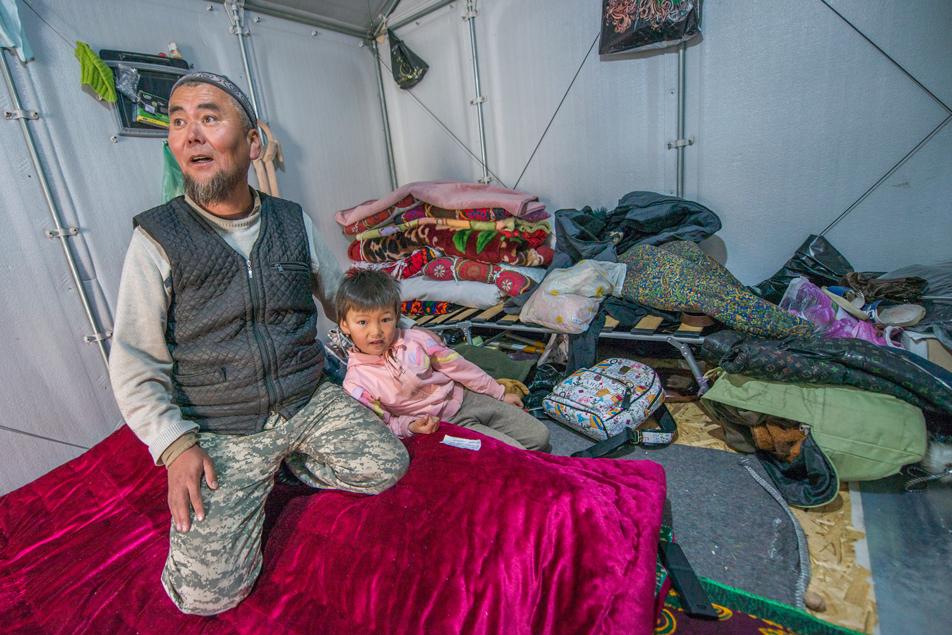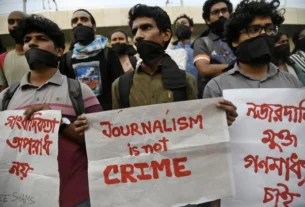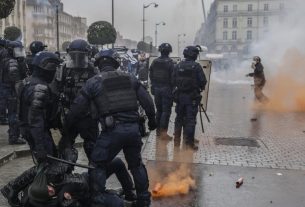Sharaf Tupchiboev had just woken up in the early hours of 16 September, when the peace was broken by gun bursts and muffled explosions. Forces from the Tajikistan and Kyrgyzstan armies had just started trading fire in what was to become a brief but intense border conflict between the two Central Asian countries. The EU and its humanitarian partners were immediately on the ground to help those affected.
Sharaf Tupchiboev, with his daughter 6-year-old Madina, lives in a temporary shelter while his house is rebuilt.
© European Union, 2023 (photographer: Peter Biro)
“I quickly gathered my wife and children and drove away in our car,” the 48-year-old farmer says, as he sits kneeling in a flimsy shelter in his home village of Min-Oruk.
The village sits in a beautiful, mountainous Kyrgyz region surrounded to the north, west and south by Tajikistan. The villagers in this region mostly make a living through farming, and growing apricots and other fruit.
“Life has always been good here,” Tupchiboev says. “But the fighting changed everything.”
The clashes, which forced some 140,000 people from their homes in Kyrgyzstan alone, involved heavy weaponry including tanks, artillery, rocket launchers, and armed drones.
Hundreds of houses and civilian infrastructure in Kyrgyzstan were set on fire and destroyed. Civilians were victims of indiscriminate attacks by both sides and more than 100 civilians, including dozens of children, were killed.
“A week later I returned, and everything was destroyed,” Tupchiboev said. “Houses were burnt to the ground and the area was full of soldiers.”
Tupchiboev, who worked on a collective farm when Kyrgyzstan was still part of the Soviet Union, and later as a day labourer in Russia, said it took him 20 years to save up for the house.
“I did every job I could find – welding, construction work,” he said. “And now there’s nothing left of my house and everything that was in it.”
Providing emergency aid

The tranquil beauty of the border region stands in stark contrast to the violence that frequently erupts between Tajikistan and Kyrgyzstan.
© European Union, 2023 (photographer: Peter Biro)
The EU’s humanitarian partners, The Kyrgyz and the Tajik Red Crescent, were on the ground immediately after the conflict.
With the EU’s support, they helped people rebuild their houses and providing other emergency aid. The needs were massive: in Min-Oruk, with just 1,000 inhabitants, over 600 houses were destroyed or damaged.
The border conflict between Tajikistan and Kyrgyzstan has a long and complex history. The main flashpoint is the Ferghana valley, which is dotted with territorial enclaves that aggravate land and water disputes in this densely populated area. Half of the 1,000-kilometer-long national border was never demarcated, following the breakup of the Soviet Union in 1991.
“The conflict in 2022 differs from the previous ones, both in scale and in the amount of damage and loss,” said Shavkat Abdujabarov, a project manager for the EU’s humanitarian partner German Red Cross in Kyrgyzstan.
“Tens of thousands of people fled their homes and were temporarily displaced to other regions of the country.”
The government of Kyrgyzstan initially provided support to the homeless families. But given the large number of affected people, they soon requested support from humanitarian organisations, including the German Red Cross.

Shavkat Abdujabarov, a project manager for the EU’s partner German Red Cross in Kyrgyzstan, talks to villagers among the ruins of Min-Oruk.
©European Union, 2023 (Photo: Peter Biro)
“People were also in dire need of food, medicine and clothes,” Abdujabarov said. “Many also needed money for rent while they were waiting for the construction of their new homes to finish. We quickly stepped in to provide cash for those most in need.”
While both sides still accuse each other of igniting the fighting, both parties signed a peace deal less than a week after the outbreak of violence. But with the unsolved root causes – from water disputes to domestic politics –, some fear that fighting could flare up again.
“We are still worried,” Sharaf Tupchiboev says. “But we will stay here forever. This is my home.”
Story by Peter Biro, Regional Information Officer for Asia and the Pacific, EU Civil Protection and Humanitarian Aid Operations.
Publication date: 07/06/2023



